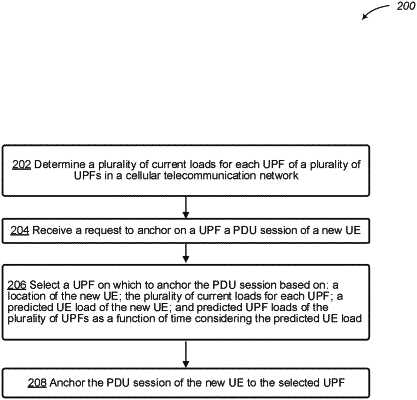| CPC H04W 28/0942 (2020.05) [H04W 28/082 (2023.05)] | 10 Claims |

|
5. A method, comprising:
determining a plurality of current loads for each user plane function (UPF) of a plurality of UPFs in a cellular telecommunication network, wherein:
the plurality of UPFs serve as anchor points between user equipment (UE) in the cellular telecommunication network and a data network (DN); and
each UPF of the plurality of UPFs is a virtual network function responsible for interconnecting packet data unit (PDU) sessions between UE and the DN by anchoring the PDU sessions on individual UPFs;
receiving a request to anchor on a UPF a PDU session of a new UE newly appearing on the cellular telecommunication network;
selecting a UPF of the plurality of UPFs on which to anchor the PDU session based on:
a location of the new UE;
the plurality of current loads for each UPF of the plurality of UPFs;
a predicted UE load of the new UE based on network data analytics; and
predicted UPF loads of the plurality of UPFs as a function of time considering the predicted UE load based on network data analytics; and
anchoring the PDU session of the new UE to the selected UPF;
the selecting a UPF of the plurality of UPFs on which to anchor the PDU session includes:
selecting a UPF of the plurality of UPFs on which to anchor the PDU session such that weights are used in performing weighted averaging to determine a predicted average load over time of each UPF of the plurality of UPFs when selecting the UPF on which to anchor the PDU session;
selecting a UPF of the plurality of UPFs on which to anchor the PDU session such that larger weight is put on consideration of shorter term predictions of UPF loads included in the predicted UPF loads than longer term predictions of UPF loads included in the predicted UPF loads when selecting the UPF on which to anchor the PDU session, which includes;
for each UPF of the plurality of UPFs, performing weighted averaging to determine a predicted average load over time of the UPF, based on an assumption the PDU session of the new UE anchors on the UPF, by using a filter that weights shorter term predictions of UPF loads of the UPF more than longer term predictions of UPF loads of the UPF in the averaging, and
selecting a UPF of the plurality of UPFs on which to anchor the PDU session based on the determined predicted average load over time of each UPF of the plurality of UPFs;
weighting selecting of a UPF of the plurality of UPFs on which to anchor the PDU session such as to favor selection of a UPF that has a current cellular telecommunication network serving area geographically covering the location of the new UE;
for each UPF of the plurality of UPFs, performing the weighted averaging to determine a predicted average load over time of the UPF is performed according to an exponential filter represented by a formula as follows;
 in which:
Avg_load_UPFi represents the determined predicted average load over time of an “i”th UPF in the plurality of UPFs, represented by UPFi;
i=1, . . . N in which N is a total number of UPFs in the plurality of UPFs;
Est_load_UPFi(t) is an estimated load of UPFi at a future point in time “t” assuming the PDU session of the new UE anchors on UPFi; and
“T” represents a time constant.
|